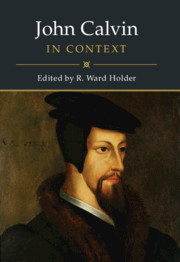Book contents
- John Calvin in Context
- John Calvin in Context
- Copyright page
- Dedication
- Contents
- Contributors
- Acknowledgments
- Abbreviations
- Introduction
- Part I France and Its Influence
- Part II Switzerland, Southern Germany, and Geneva
- Part III Empire and Society
- 15 The Politics of the Emperors
- 16 Judaism in Europe during the Late Middle Ages and Renaissance
- 17 Refugees
- 18 Calvin and Women
- Part IV The Religious Question
- Part V Calvin’s Influences
- Part VI Calvin’s Reception
- Conclusion
- Bibliography
- Index
- References
17 - Refugees
from Part III - Empire and Society
Published online by Cambridge University Press: 14 November 2019
- John Calvin in Context
- John Calvin in Context
- Copyright page
- Dedication
- Contents
- Contributors
- Acknowledgments
- Abbreviations
- Introduction
- Part I France and Its Influence
- Part II Switzerland, Southern Germany, and Geneva
- Part III Empire and Society
- 15 The Politics of the Emperors
- 16 Judaism in Europe during the Late Middle Ages and Renaissance
- 17 Refugees
- 18 Calvin and Women
- Part IV The Religious Question
- Part V Calvin’s Influences
- Part VI Calvin’s Reception
- Conclusion
- Bibliography
- Index
- References
Summary
John Calvin may be the most famous Reformation-era refugee.1 Born in northern France, Calvin fled probable persecution in 1534, finally settling in his new home of Geneva in 1541, where he became a towering religious reformer. Historians have treated Calvin not just as a reformer of Geneva but also as a reformer in Geneva, who understood the Reformation as part of a broader international (or perhaps better put, universal) struggle for truth in a battle that went beyond the confines of any civic jurisdiction. During Calvin’s time, Geneva – a city of about 10,000 inhabitants – doubled in size as a result of Reformed Protestant refugees coming from France. As Geneva became known as a welcome asylum for Reformed Protestants fleeing persecution, refugees came from elsewhere as well. As the English exile John Bale living in Geneva wrote of that city, “[I]s it not wonderful that Spaniards, Italians, Scots, Englishmen, Frenchmen, Germans, disagreeing in manners, speech, and apparel … being coupled only with the yoke of Christ, should live so lovingly and friendly … like a spiritual and Christian congregation.”2 Reformed Refugees fled France not just for Geneva, but for Strasbourg, Basel, Metz, Montbéliard, and elsewhere. Meanwhile, English Protestants made temporary homes in Basel, Zurich, Wesel, and other continental cities. Estimates suggest that as many as 100,000 Flemish and Walloon Protestants fled the Low Countries for cities in England and the Holy Roman Empire, including London, Cologne, Hamburg, and Frankfurt. Like Geneva, exile centers like Emden and Wesel doubled in size by the 1560s and 1570s. There is no doubt that these experiences profoundly shaped Calvin and his co-religionists. But how distinctive were those changes? To answer that question, this chapter will summarize the experience of religious expulsion as a mass phenomenon across the long sixteenth century (1490s–1610s).
Keywords
- Type
- Chapter
- Information
- John Calvin in Context , pp. 147 - 154Publisher: Cambridge University PressPrint publication year: 2019

